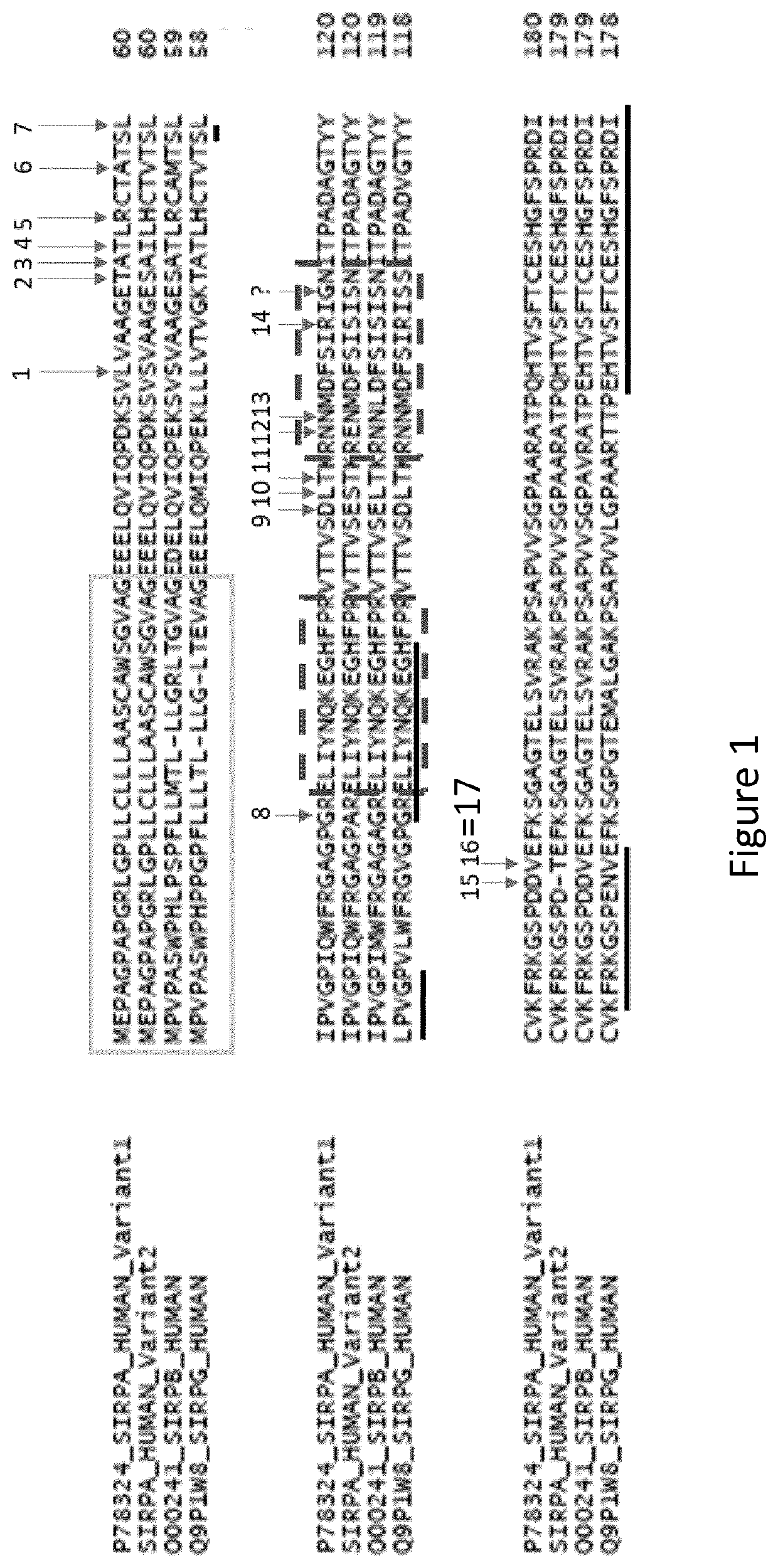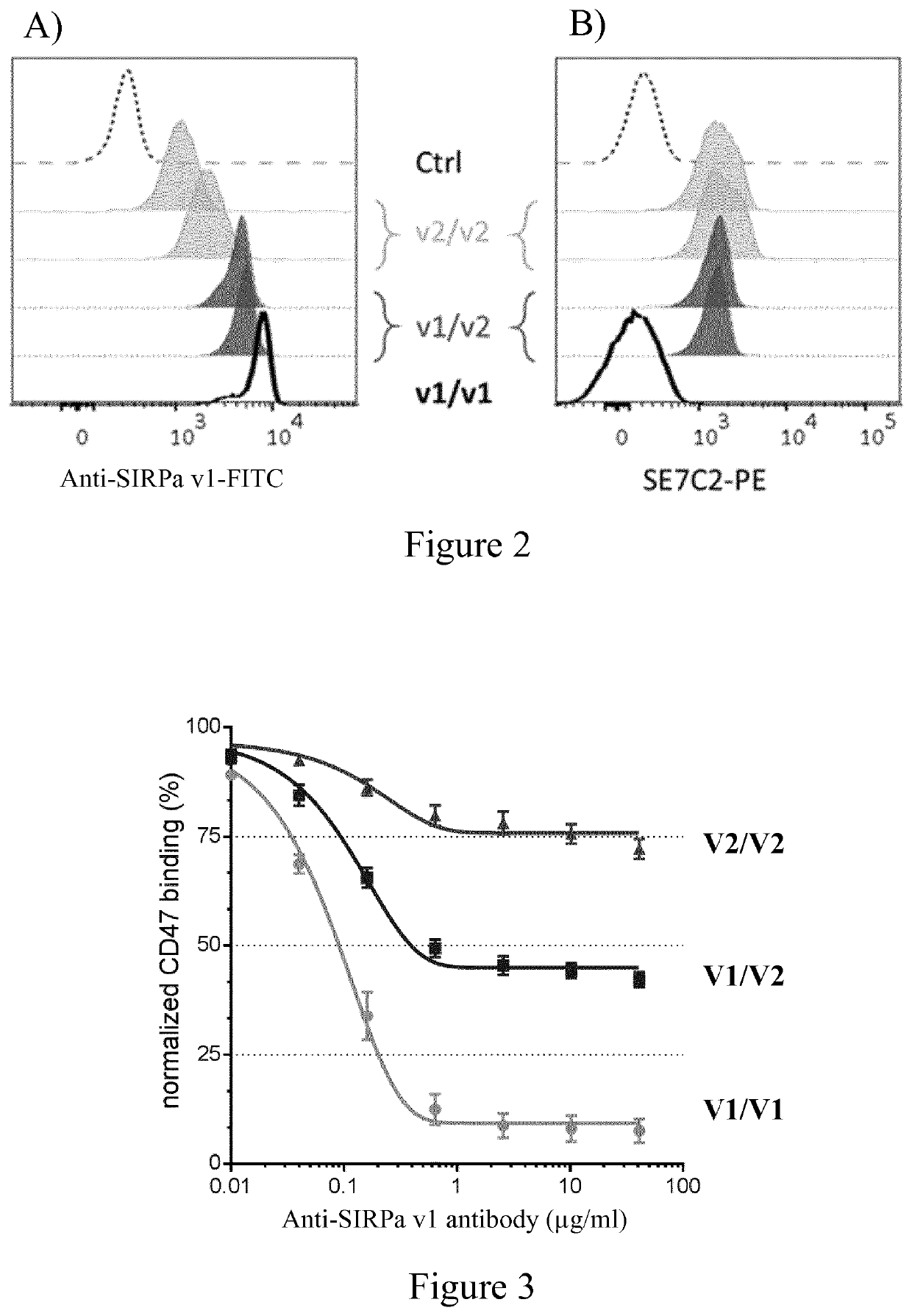Use of Anti-human sirpa v1 antibodies and method for producing Anti-sirpa v1 antibodies
a technology of human sirpa and anti-human sirpa, which is applied in the direction of immunoglobulins, peptides, drugs, etc., can solve the problems of poor outcome, anti-cd47 agents present hematological toxicity related, anemia or thrombocytopenia,
- Summary
- Abstract
- Description
- Claims
- Application Information
AI Technical Summary
Benefits of technology
Problems solved by technology
Method used
Image
Examples
example 1
ation of the Epitope which Allows the Production of Anti-Human SIRPa v1 Antibodies
[0273]Human SIRPa was previously described to present some level of polymorphism in IgV domain 1 which interacts with CD47. This polymorphism is mainly located in the exon 3 of SIRPa gene (SEQ ID No: 27) (Takenaka et al., 2007). On 37 different donor's genomic sequences from different origin, Takenaka et al. identified 10 different sequences / alleles, with 2 principal alleles: variant 1 (v1) and variant 2 (v2). Other alleles differ from V1 or V2 sequences by only 1 or 2 SNPs. Therefore, the SIRPa family is sub-divided into two sub-families: SIRPa v1 isoforms and SIRPa v2 isoforms. These different alleles lead to slightly different proteins, but all variants bind similarly CD47 ligand. Allelic frequency of v1 in Takenaka et al. is 78% (89% for V1 and V1-like) while genotype frequency for homozygous V1 / V1-like donors is 65%. 24% of their 37 donors presented a heterozygous genotype.
[0274]Coding DNA and Pro...
example 2
n of SIRPa-CD47 Interaction Blockade on Immune Cross Presentation Between Mouse and Human
[0295]Mouse Cross-Presentation (FIG. 5)
[0296]DRUGS: the allosteric antagonist monoclonal antibody targeting the domain 2 of the mouse SIRPa (P84 clone—rat IgG1) was purified from hybridoma. The orthosteric antagonist monoclonal antibody targeting the domain 1 of the mouse SIRPa (MY-1 clone—mouse IgG2a) (Garcia et al., 2011) was reengineered into an IgG1 Fc domain from the parental hybridoma. Both anti-SIRPa antibodies block the signaling through SIRPa in myeloid cells. The isotype control mouse IgG1 (3G8 clone) was purified. The surrogate antagonistic anti-mouse CD47 monoclonal antibody (MIAP410 clone) was purchased from BioXCell (#BE0283).
[0297]MOUSE SIRPa EXPRESSION BY SPLENIC DCs: natural DC were isolated from the spleen of naïve mice by CD11c positive magnetic selection and separated for their CD8α expression by cell sorting with a BD FACS ARIA II. As described in the literature, CD8α+ / +DC, ...
example 3
SIRP / CD47 Blockade on Polyclonal Stimulation
[0314]METHOD: hPBMC were isolated from buffy coat of healthy volunteers. CD4 or CD8 T cells were selected by positive selection using an AutoMACS (Miltenyi) and plated in 96-round well plate (50 000 cells / well). The proliferative signals were provided by either anti-CD3 / anti-CD28 coated microbeads (Life Technologies) at a 1 bead for 1 T cell ratio during three days, or allogeneic mature dendritic cells generated in vitro at a 5 T cell for 1 mDC during 5 days. Antibodies targeting the SIRPa / CD47 and / or the SIRPg / CD47 pathways were added from the beginning of the proliferation test at a saturating concentration (10 μg / mL). Proliferation was measured by incorporation of H3-thymidine during the last 12 h of culture. Anti-CD47 antibody (commercial references: B6H12), anti-SIRPa antibodies (HEFLB as referred in the patent (WO2017178653)).
[0315]RESULTS: to investigate the immunosuppressive effect of the blockade of CD47 on human T lymphocytes, PB...
PUM
| Property | Measurement | Unit |
|---|---|---|
| Time | aaaaa | aaaaa |
| Affinity | aaaaa | aaaaa |
Abstract
Description
Claims
Application Information
 Login to View More
Login to View More - R&D
- Intellectual Property
- Life Sciences
- Materials
- Tech Scout
- Unparalleled Data Quality
- Higher Quality Content
- 60% Fewer Hallucinations
Browse by: Latest US Patents, China's latest patents, Technical Efficacy Thesaurus, Application Domain, Technology Topic, Popular Technical Reports.
© 2025 PatSnap. All rights reserved.Legal|Privacy policy|Modern Slavery Act Transparency Statement|Sitemap|About US| Contact US: help@patsnap.com



